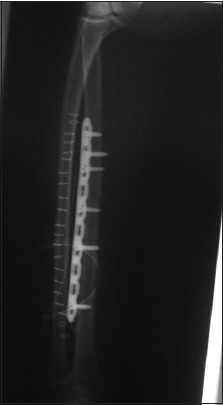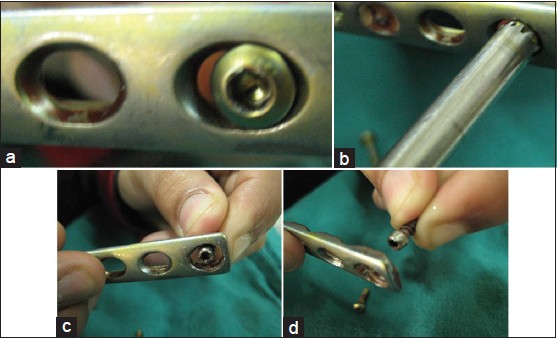|


 |
| SURGICAL TECHNIQUE |
|
| Year : 2014 | Volume
: 6
| Issue : 1 | Page : 9-11 |
|
|
Hollow mill for extraction of stripped titanium screws: An easy, quick, and safe technique
Ravi Gupta, Harpreet Singh, Amit Singh, Sudhir Garg
Department of Orthopaedics, Government Medical College Hospital, Sector 32B, Chandigarh, Punjab and Haryana, India
| Date of Web Publication | 24-Jun-2014 |
Correspondence Address:
Ravi Gupta
Department of Orthopaedics, Government Medical College Hospital, Sector 32B, Chandigarh 160 031
India
 Source of Support: None, Conflict of Interest: None
DOI: 10.4103/2006-8808.135135

 Abstract Abstract | | |
Removal of jammed titanium screws can be difficult due to the problem of stripping of the hexagonal heads of the screws. We present a technique of extraction of stripped screws with the use of a standard 4.5 mm stainless steel hollow mill in a patient of peri-implant fracture of the radius fixed with a titanium locking plate 2 years back. The technique is quick, safe, and cost effective. Keywords: Hollow mill, stripped screws, titanium locked plates, titanium plates
How to cite this article:
Gupta R, Singh H, Singh A, Garg S. Hollow mill for extraction of stripped titanium screws: An easy, quick, and safe technique. J Surg Tech Case Report 2014;6:9-11 |
How to cite this URL:
Gupta R, Singh H, Singh A, Garg S. Hollow mill for extraction of stripped titanium screws: An easy, quick, and safe technique. J Surg Tech Case Report [serial online] 2014 [cited 2016 May 10];6:9-11. Available from: http://www.jstcr.org/text.asp?2014/6/1/9/135135 |
 Introduction Introduction | |  |
Hardware removal is a common surgery in orthopedics. [1],[2] Difficulty in removal of stripped screw heads is one of the most commonly encountered problem in such procedures. [3],[4] The standard devices designed for this situation include diamond-tipped carbide drill, trephine, counter clock device, and extraction bolts. However, there is no single technique which is universally successful. [3],[4],[5] Availability of such devices is another practical problem especially in developing countries. The known alternative in such condition is cutting through the screw head with an osteotome or some other sharp instrument, and recently to make radial cuts in plate. [5] However, the risk of causing a new fracture in the bone in using an osteotome for cutting the screw or plate can lead to a difficult situation especially in revision trauma surgery for non union or peri-implant fracture.
We herewith report a technique of removal of titanium plate in a case of peri-implant fracture of the radius by using a hollow mill which is actually designed to extract a jammed screw by cutting the bone around the screw.
 Case report Case report | |  |
A 38-year-old male presented to our institution for peri-implant fracture of left radius that occurred after two years of radius plating with LC DCP (Synthes, India). The X-ray showed a transverse fracture of the left radius at the proximal end of the plate [Figure 1]. After routine examination and work up, the patient was taken up for surgery.
During the surgery, removal of the two screws from the plate on the opposing ends of the plate was difficult and resulted in stripping of the sockets of the screw heads [Figure 2].
The tapering drill bit designed for removal of titanium screws by cutting the threads in the shaft of the screw in the reverse drilling direction was not available. We used a locally manufactured stainless steel hollow mill, actually designed to cut the bone around screw during jammed screw removal from the bone. Using it in a high-speed drill, we were able to grate out the titanium metal at the plate hole - screw head interface which facilitated the plate removal. The protruding screw heads from the bone were then easily held by a nose plier and removed by rotatory motion. To prevent contamination of local tissue by metal particles, wet gauge pieces were kept around each side of the plate. The fracture was reduced and fixed with a new 10-hole titanium locking plate, making new holes on each side of peri-implant fracture [Figure 3]. | Figure 3: X-ray after removal of the original implant and application of the new implant
Click here to view |
The wound was washed using high-volume, low-pressure system to clear the wound of possible contamination from very small metal particles. It took us about 7 minutes each to grate out the metal around each screw head and total duration of surgery was 2 hours.
No complication was observed during postoperative period. There has been no systemic or local complication up till 2 years of follow-up.
Figure 4a-d experimentally demonstrate the steps of removal of a screw from one of the undamaged holes of the extracted titanium plate by reproducing the steps used in the surgery.
 Discussion Discussion | |  |
Jamming of the screw heads with the titanium plates is a known problem. [3],[4] The stripping of the hexagonal recess of the titanium screws is more common in 3.5 mm screws. [6] Instruments used for removal of the jammed screws, including conical extraction screws, hollow reamers, extraction bolts, modular devices, and carbide drill bits, do not always work. [5] The use of conical extraction screw which was developed especially for the removal of stripped locking screws has been reported to be successful only in 25% of the cases of extraction of 3.5 mm stripped screws. [6] Furthermore, the availability of all the instruments recommended by the manufacturer is mostly not possible in the developing countries due to the concerns of the cost of surgery.
Metal cutting saw is another safe and effective method of removal of jammed and stripped screws. [5],[6] However, the method requires the availability of a metal-cutting saw in the armamentarium with small-sized disposable blades, resulting in the escalation of the cost. In addition, we feel, it is likely to require a wider surgical exposure than the standard one for the movement of the saw blade on the plate. Furthermore, in cold welded locked screws, the extent of cold welding being variable from case to case, the making of radial cuts in the plates around the holes and then the use of the osteotome may not always be successful in a situation where a thorough cold welding all around the head of the screw has created the "screw head - plate hole" assembly as a mono-block single unit. In such a situation, enlarging the hole of the plate by grating the soft titanium cold welded metal/metal around the plate hole by the stainless steel hollow mill proves to be a good alternative. Since the principle of the present technique is based on the enlarging of the size of hole in the plate rather than reducing the size of the screw head [Figure 4]b], the technique can be applicable to the stripped screws in the case of cold welded locking screws as well. | Figure 4: (a) Stripped head of a jammed screw (b) Use of high-speed stainless steel hollow mill around the head of the screw (c) Enlarged hole of the plate after grating of the metal from the periphery of the hole (d) Screw head passing through the enlarged hole
Click here to view |
The present procedure is simple and quick that can be performed universally without any specific inventory of tools. A stainless steel hollow mill, which is a part of the standard DCP sets, is mostly universally available. The stainless steel being harder than titanium, the high-speed rotation of the mill quickly grinds the holes of the titanium plate making it wide enough to allow the passage of the screw head [Figure 4]a-d].
The present procedure as well as the procedure of cutting the plate with a metal cutting saw have the potential risks of spillage of metal particles into the soft tissue planes, resulting in the future risk of metallosis. We were able to avoid this problem by packing wet gauge pieces around the plate during the use of hollow mill and subsequent thorough irrigation of the wound.
 Conclusion Conclusion | |  |
Hollow mill is an easily available good instrument for quick and safe removal of jammed and stripped cold welded titanium screws.
 References References | |  |
| 1. | Stafford P, Norris BL, Nowotarski PJ. Hardware removal: Tips and techniques in revision fracture surgery. Techs in Orthop 2002;17:522-30. 
|
| 2. | Busam ML, Esther RJ, Obremskey WT. Hardware removal: Indications and expectations. J Am Acad Orthop Surg 2006;14:113-20. 
|
| 3. | Suzuki T, Smith WR, Stahel PF, Morgan SJ, Baron AJ, Hak DJ. Technical problems and complications in the removal of the less invasive stabilization system. J Orthop Trauma 2010;24:369-73. 
|
| 4. | Hak DJ, McElvany M. Removal of broken hardware. J Am Acad Orthop Surg 2008;16:113-20. 
|
| 5. | Kumar G, Dunlop C. Case report: A technique to remove a jammed locking screw from a locking plate. Clin Orthop Relat Res 2011;469:613-6. 
|
| 6. | Bae JH, Oh JK, Oh CW, Hur CR. Technical difficulties of removal of locking screw after locking compression plating. Arch Orthop Trauma Surg 2009;129:91-5. 
|
[Figure 1], [Figure 2], [Figure 3], [Figure 4]
|